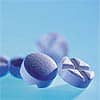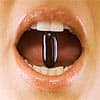
What's Hot
What's Hot
News flashes are posted here frequently to keep you up-to-date with the latest advances in health and longevity. We have an unparalleled track record of breaking stories about life extension advances.
Green tea fights superbugs
Green tea is consumed by many Egyptians, yet its potential interaction with antibiotic treatment had not been evaluated. “We tested green tea in combination with antibiotics against 28 disease causing micro-organisms belonging to two different classes,” Dr Mervat Kassem of Alexandria University's Faculty of Pharmacy explained. “In every single case green tea enhanced the bacteria-killing activity of the antibiotics. For example the killing effect of chloramphenicol was 99.99% better when taken with green tea than when taken on its own in some circumstances.” One of the drugs enhanced by green tea belongs to a class of broad-spectrum antibiotics known as cephalosporins, which newly evolved strains of bacteria are able to resist. Twenty percent of drug-resistant bacteria tested were found to be susceptible to the antibiotic's effects when its forces were combined with green tea. Tea appears to lower bacterial drug resistance while increasing the action of antibiotics, sometimes at low concentrations. “Our results show that we should consider more seriously the natural products we consume in our everyday life,” Dr Kassem stated. “In the future, we will be looking at other natural herb products such as marjoram and thyme to see whether they also contain active compounds which can help in the battle against drug resistant bacteria”. —D Dye Apples may offer protection against colorectal cancer
Dieter Schrenk, MD of the University of Kaiserslautern in Germany and his colleagues studied human fecal matter incubated with apple pectin or polyphenol-rich apple juice extract. During fermentation, both substances (with pectin having the greater effect) increased the production of a short chain fatty acid known as butyrate, which is believed to be a major contributor to healthy colon mucosa. “Butyrate not only serves as a major nutrient for the colon epithelia but is also thought to play an important role in the protective effect of natural fiber against colorectal cancer," the authors explain. Both apple pectin and polyphenol-rich apple juice extract were associated with inhibition of histone deacetylases (HDAC), which plays a role in differentiation and apoptosis. Increasing this process would result in significantly less growth of precancerous and tumor cells. The authors suggest that butyrate is the most relevant inhibitor of HDAC formed in the fermentations, and that the comparable inhibition of HDAC by both pectin and apple juice extract despite the lower butyrate yield of the latter compound may be due to yet unknown HDAC inhibitors in apple juice. “Pectin-rich apple products can thus be expected to exert anticarcinogenic effects in the colon,” the authors conclude. —D Dye Promising future predicted for resveratrol
Paul Okunieff, MD and his associates at the University of Rochester Medical Center pretreated pancreatic cancer cells with 50 mg/ml resveratrol before exposing them to ionizing radiation. A second group of cells received radiation therapy alone. The researchers found that cancer cells treated with resveratrol experienced an increase in destructive reactive oxygen species, which are the likeliest cause of the apoptosis (programmed cell death) observed. Additionally, mitochondrial membrane polarization was greater in the resveratrol-treated cells, which reduces the cells' ability to function. The ability of the pancreas to pump out digestive enzymes also removes drugs from its cells, which explains the resistance of pancreatic cancer to chemotherapy. Dr Okunieff's team found that cell membrane proteins that are responsible for pumping chemotherapy out of the cells underwent a decline in function in cells treated with resveratrol, rendering them more sensitive to drug treatment. In another article in the same issue of the journal, Dr Okunieff and his colleagues reviewed why resveratrol protects normal tissue. "Antioxidant research is very active and very seductive right now," Dr Okunieff commented. "The challenge lies in finding the right concentration and how it works inside the cell. In this case, we've discovered an important part of that equation. Resveratrol seems to have a therapeutic gain by making tumor cells more sensitive to radiation and making normal tissue less sensitive." "While additional studies are needed," Okunieff said, "this research indicates that resveratrol has a promising future as part of the treatment for cancer." —D Dye Review finds aspirin may help treat as well as prevent breast cancer
A. Agrawa and Professor Ian S. Fentiman of Guy's Hospital in London reviewed 21 studies published between 1980 and 2007 which included a total of over 37,000 participants. Eleven of the studies involved women with breast cancer and ten compared women with and without the disease. The duo concluded that women who used NSAIDs had a 20 percent lower risk of developing breast cancer than those who did not use the drugs. “The purpose of a review like this is to look at a wide range of published studies and see if it is possible to pull together all the findings and come to any overarching conclusions,” Dr Fentiman explained. "Our review of research published over the last 27 years suggests that, in addition to possible prevention, there may also be a role for NSAIDs in the treatment of women with established breast cancer. NSAID use could be combined with hormone therapy or used to relieve symptoms in the commonest cause of cancer-related deaths in women.” “Recent studies of NSAIDs use have shown about a 20 per cent risk reduction in the incidence of breast cancer, but this benefit may be confined to aspirin use alone and not other NSAIDs," Dr Fentiman noted. Although Dr Fentiman recognized the need for further studies, he concluded that the current findings "clearly indicate that these popular over-the-counter drugs could, if used correctly, play an important role in preventing and treating breast cancer.” —D Dye Resveratrol protects against diabetes-induced blood vessel damage
Lead researcher Dr Matt Whiteman, who is Senior Lecturer at Peninsula Medical School's Institute of Biomedical and Clinical Science commented, “Resveratrol’s antioxidant effects in the test tube are well documented but our research shows the link between high levels of glucose, its damaging effect on cell structure, and the ability of resveratrol of protect against and mend that damage.” “Resveratrol or related compounds could be used to block the damaging effect of glucose which in turn might fight the often life threatening complications that accompany diabetes," he added. "It could well be the basis of effective diet-based therapies for the prevention of vascular damage caused by hyperglycemia in the future.” —D Dye Melatonin helps prevent secondary infection in inflammatory bowel disease
In the current study, Dr Alper Akcan and associates induced colitis in 20 rats, and gave half of them intraperitoneal injections of melatonin for the following ten days. The remainder of the animals received injections of saline. Ten rats without colitis were used as controls. At the end of the treatment period, plasma tumor necrosis factor-alpha (a marker of inflammation), portal blood endotoxin (potentially toxic compounds found in bacteria), colon tissue myeloperoxidase (a protein that promotes inflammation) and caspase-3 (a marker of apoptosis, or programmed cell death) activity were measured. Cultures of the blood, lymph nodes, liver and spleen were used to determine the extent of bacterial translocation. The researchers observed a significant reduction of bacterial translocation to the liver, spleen, mesenteric lymph nodes, and portal and systemic blood among rats that received melatonin. Tumor necrosis factor-alpha, endotoxin, myeloperoxidase and caspase-3 levels were lower among the melatonin-treated animals, demonstrating a reduction in inflammation and apoptosis. To the authors' knowledge, the study is the first to reveal the relationship between colitis, melatonin, and bacterial translocation. "Further investigations are required to clarify whether melatonin is an effective and safe therapy for IBDs in human beings," the authors conclude. —D Dye Meta-analysis finds children who are supplemented with vitamin D have a lower risk of developing diabetes
For the current review, C. S. Zipitis, of the Stockport NHS Foundation Trust in Stockport, and A. K. Akobeng, of Booth Hall Children's Hospital in Manchester, England selected four case-control studies and one cohort study, involving a total of 6,455 children. Of these children, 1,429 developed type 1 diabetes. Analysis of the case-control studies determined that infants who were supplemented with vitamin D had a 29 percent lower risk of developing diabetes than those who were not. Data from the cohort study supported this conclusion. Increased dosages of the vitamin were associated with a greater reduction in diabetes risk than lower doses. In one study included in the review, those who received vitamin D from cod liver oil between the ages of 7 and 12 months experienced a lower risk of developing type 1 diabetes than infants supplemented between 0 and 6 months. Other forms of the vitamin were associated with similar results. Since type 1 diabetes is an autoimmune disorder in which the beta cells of the pancreas that produce insulin are destroyed, a protective effect of vitamin D on the immune system as well as on pancreatic beta cells may be mechanisms by which vitamin D helps prevent the disease. Both types of cells have receptors for the active forms of the vitamin. "Vitamin D supplementation in early childhood may offer protection against the development of type 1 diabetes," the authors conclude. "Adequately powered, randomised controlled trials with long periods of follow-up are needed to establish causality and the best formulation, dose, duration and period of supplementation." —D Dye Mayo Clinic publication reviews omega-3 fatty acids
James O’Keefe, MD, of the Mid America Heart Institute in Kansas City, Missouri, and his colleagues discussed the benefits of the omega-3 fatty acids eicosapentaenoic acid and docosahexaenoic acid (EPA and DHA), found in oily fish, fish oil, and algae. “The most compelling evidence for the cardiovascular benefit provided by omega-3 fatty acids comes from three large controlled trials of 32,000 participants randomized to receive omega-3 fatty acid supplements containing DHA and EPA or to act as controls,” Dr O’Keefe stated. “These trials showed reductions in cardiovascular events of 19 percent to 45 percent. Overall, these findings suggest that intake of omega-3 fatty acids, whether from dietary sources or fish oil supplements, should be increased, especially in those with or at risk for coronary artery disease.” “Patients with high triglyceride levels can benefit from treatment with 3 to 4 grams daily of DHA and EPA,” Dr O’Keefe suggests. “Research shows that this dosage lowers triglyceride levels by 20 to 50 percent.” Additionally, the supplements can be combined with statin drugs to improve cholesterol levels. Because consuming two meals containing oily fish will only provide 400 to 500 mg of DHA and EPA, those who need higher amounts of omega-3 fatty acids can use supplements to reach these levels. The supplements are relatively inexpensive and have little in the way of side effects. "In prospective placebo-controlled trials, no adverse effects were observed to occur at a frequency of more than 5 percent, and no difference in frequency was noted between the placebo and omega-3 fatty acid groups,” Dr O'Keefe noted. —D Dye Typical American diet short on omega-3 fatty acids
Sheila M. Innes and Russell W. Friesen of the University of British Columbia in Vancouver assigned 135 pregnant women to a placebo or a daily omega-3 fatty acid supplement equivalent to two fatty fish meals per week, beginning with their 16th week of gestation until delivery. The women's blood was tested for levels of the omega-3 fatty acid docosahexaenoic acid (DHA) at the 16th and 36th weeks. DHA plays an important role in brain and eye function, and is essential for the neurological development of unborn children. Following their birth, the infants were evaluated for neurological maturity using vision tests. The investigators discovered that women who consumed large quantities of meat and low amounts of fish had omega-3 fatty acid deficiencies. Children of these women failed to perform as well on the eye tests as infants born to mothers who were not deficient. The duo plans to follow the development of the children until they are four years old. “Omega 3 fatty acids are important for the baby’s developing eyes and brain,” explained Dr Innis, who is a professor at the University of British Columbia's department of pediatrics. “During pregnancy and breastfeeding, fat consumed by the mum is transferred to the developing baby and breastfed infant, and this fat is important for the baby’s developing organs. Our next task is to find out why the typical North American diet puts mothers at risk. Then we can develop dietary recommendations to help women consume a nutritious diet that promotes optimal health for mums and babies.” —D Dye Broccoli compound boosts immune function in old mice
Andre E. Nel, MD, PhD and his associates at the University of California Los Angeles David Geffen School of Medicine tested the effects of sulforaphane on two aspects of immune function in aged mice. They found that sulforaphane reversed the age-associated decline in immune function observed in the animals, by switching on antioxidant genes and enzymes in certain immune cells which enable them to fight free radicals. "The mysteries of aging have always intrigued man," Dr Nel commented. "While we have known for some time that free radicals are important in aging, most of the past attention has focused on the mechanisms that produce free radicals rather than addressing the pathways used by the body to suppress their production." "As we age, the ability of the immune system to fight disease and infections and protect against cancer wears down as a result of the impact of oxygen radicals on the immune system," he observed. "Our defense against oxidative stress damage may determine at what rate we age, how it will manifest and how to interfere in those processes." "In particular, our study shows that a chemical present in broccoli is capable of stimulating a wide range of antioxidant defense pathways and may be able to interfere with the age-related decline in immune function." he concluded. "Our study contributes to the growing understanding of the importance of these antioxidant defense pathways that the body uses to fight free radicals. Insight into these processes points to ways in which we may be able to alleviate the effects of aging. —D Dye Study finds reduced vitamin B6 and elevated homocysteine levels more prevalent in rheumatoid arthritis patients
The duo enrolled 18 women with rheumatoid arthritis and 33 healthy women without the disease between the ages of 55 and 82. Responses to dietary questionnaires which recorded 7 day weighed food intake were analyzed for calories, folate, vitamin 12, vitamin B6, and other nutrients. Participants also completed health assessment and pain questionnaires. Blood samples were analyzed for homocysteine, lipids, CRP, plasma and red blood cell folate, vitamin B12, and pyridoxal 5' phosphate (PLP), the metabolically active coenzyme form of vitamin B6. Drs Woolf and Manore discovered that women with rheumatoid arthritis had significantly lower PLP levels than those without the disease. While healthy participants had levels of the vitamin that averaged 11.35 nanograms per milliliter, levels among women with rheumatoid arthritis averaged 4.93 ng/mL, even though dietary intake of the vitamin between the groups was similar. Red blood cell folate levels were also lower in the arthritis patients, and plasma total homocysteine levels significantly higher. The authors suggest that, compared to those without the disease, rheumatoid arthritis patients may have a higher requirement for vitamin B6 in order to cope with greater levels of inflammation. "Individuals with rheumatoid arthritis may need to get more B vitamins through diet, supplements, or fortified foods," the authors conclude. —D Dye Low fat beats low carb in heart disease prevention
Although both diets have their adherents in regard to their weight-loss results, concern exists that the higher fat content of low carbohydrate diets could increase cardiovascular disease risk. For the current investigation, David D. Gutterman, MD of the Medical College of Wisconsin in Milwaukee and his colleagues assigned 20 obese participants to a low fat diet, providing 30 percent of its calories in the form of fat, or a low carbohydrate diet for six weeks. Brachial flow-mediated dilation, which evaluates endothelial function, was measured at the beginning of the study, during the second week, and at the study's conclusion. Blood pressure, weight, and cholesterol were measured throughout the trial. Although all subjects experienced improvements in weight and blood pressure, the percentage of arterial flow-mediated dilation declined among those who followed the low carbohydrate diet, while significantly improving in the low fat group. “We observed a reduction in brachial artery flow-mediated dilation after six weeks of weight loss on a low-carbohydrate, Atkins’-style diet,” stated Dr. Gutterman. “The higher fat content of a low-carbohydrate diet may put dieters at an increased risk of atherosclerosis because low-carbohydrate diets often reduce protection of the endothelium, the thin layer of cells that line the blood vessels of the circulatory system. The reduced production from the endothelium of nitric oxide, a specific chemical, puts the vessel at higher risk of abnormal thickening, greater clotting potential, and cholesterol deposition, all part of the atherosclerosis process.” An addition risk incurred by low-carbohydrate diets is their reduced levels of folic acid, a B vitamin that helps lower homocysteine. “The composition of diet may be as important as the degree of weight loss in determining the effect of dietary interventions on vascular health,” Dr. Gutterman observed. —D Dye |

 Fast on the heels of research that demonstrated green tea's potential as an anti-bioterrorism weapon, Egyptian scientists revealed this week that the drink can also help boost the activity of antibiotics against treatment-resistant bacteria, or "superbugs" that have emerged as a major challenge to 21st century medical science. The finding was reported at the at the Society for General Microbiology’s 162nd meeting, held at the Edinburgh National Conference Centre from March 31 to April 4, 2008.
Fast on the heels of research that demonstrated green tea's potential as an anti-bioterrorism weapon, Egyptian scientists revealed this week that the drink can also help boost the activity of antibiotics against treatment-resistant bacteria, or "superbugs" that have emerged as a major challenge to 21st century medical science. The finding was reported at the at the Society for General Microbiology’s 162nd meeting, held at the Edinburgh National Conference Centre from March 31 to April 4, 2008.  A report published in the April, 2008 issue of the journal
A report published in the April, 2008 issue of the journal  An article published in the March, 2008 issue of
An article published in the March, 2008 issue of  A review published in the March, 2008 issue of the
A review published in the March, 2008 issue of the  A research letter published in the April, 2008 issue of the journal
A research letter published in the April, 2008 issue of the journal  The February 14, 2008 issue of the
The February 14, 2008 issue of the  A review published online on March 13, 2008 in the journal
A review published online on March 13, 2008 in the journal  A report published in the March, 2008 issue of
A report published in the March, 2008 issue of  The March, 2008 issue of the
The March, 2008 issue of the  An article published online on March 6, 2008 in the
An article published online on March 6, 2008 in the  The March, 2008 edition of the
The March, 2008 edition of the  The February, 2008 issue of
The February, 2008 issue of 